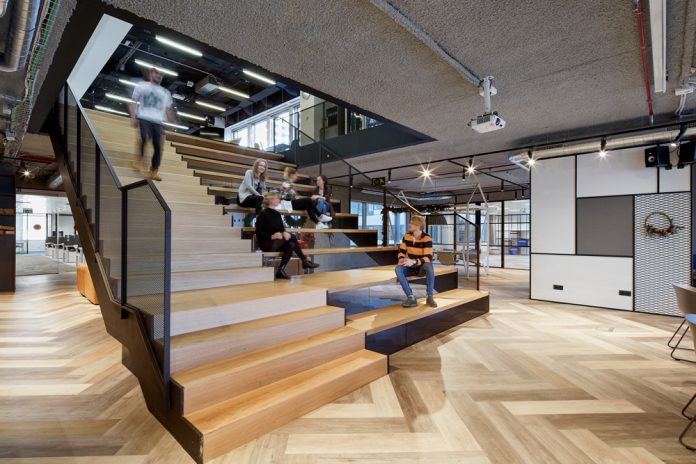Examining the new Happiness at Work initiative at SAP
“The term is loaded. It doesn’t mean I’m walking around all day telling jokes and wearing a red nose.”
I’m talking to Toby Haug, head of the new Happiness at Work pilot at SAP. Based in Barcelona and having traversed a long career in design thinking that took him from the US to Germany and now the Catalan capital, he is a little nervous at being called SAPs first Chief Happiness Officer – but that is what he is.
And he is a happy person. With a warm personality and infectious smile, he talks about the challenges ahead and some opening moves for this board-supported initiative that includes 400 commercial sales staff between Barcelona, Cairo, and Dublin.
Are you happy at work? For many, it’s an oxymoron, yet if we’re spending most of our life at work, or at least thinking about it, it’s a worthy pursuit. If you are happy at work think for a moment on why that is. And also if you’re not. What are the reasons for this lack of happiness?
I’m guessing there will be elements of the following in that reflection: of social connection or community that provides safety, using ones’ talents fully and for something bigger than oneself, and feeling empowered and having ownership over many aspects of the work itself.
Empowerment, in particular, has been present in the first months of the SAP pilot, from allowing different groups within each location to personalize their physical space to supporting the process whereby managers are selected by the team themselves.
Space personalization is supported by an allocated budget for each team to take full ownership and therefore responsibility for the space. As Toby comments, “we spend more time in the office than our living rooms, and yet it is often the least personalized space we inhabit.” The democratic form of managerial selection, though yet to be fully implemented, has significant potential in incentivizing all team members to more fully collaborate across the team and gently nudge them to treat everyone with respect.
This empowered work, where there is a focus to bring decision-making power downwards is one of three areas of behaviour focus in these initial stages of the pilot. Creating and strengthening authentic relationships is another which helps to build a fabric of trust in the organization and the third, sustainable success, which closely considers the human factor in any business success that is enjoyed.
Culture is critical for Toby and just as critical is being able to build on an existing positive culture at SAP which supports health and wellbeing, on the physical, mental and organizational levels. The company has long ascribed to such an approach recognizing that well and happy employees lead to happy customers. A focus on culture keeps the simple questions including how we work, and are we acting according to our values? top of mind. It also allows a focus on the collective rather than the individual. The main objective is to align around a set of behaviours that connect the culture to happiness.
It will be interesting to see where this goes. Starting such an initiative within a sales function might not have been the obvious choice for many given the particular profile of sales – targets and associated stress particularly – which challenge notions of happiness. Further, with a target audience comprised of 96% millennials (the company leadership of the future of course) how transferrable will the findings be to the workforce at large? And will any marked differences be observed between the three pilot locations? What difference will climate make for example, between a rainy Dublin and sunny Barcelona? Or city infrastructure or night-life for these, mostly, young driven professionals? There are some interesting tools and experiments in play, and we’ll revisit some of these in the second part of this case when we focus on design thinking and the financial benefits of happiness.
So what can you do to be happier at work, in the (likely) absence of your own happiness at work initiative and Chief Happiness Officer? I think there’s an argument for simply bringing more of yourself, your true self, to the workplace. Try to engage more with others – make a new, or develop an existing friendship. Involve yourself in work and work-related activities that excite you, even if it’s not strictly part of your job description. Listen more, smile more, even if you don’t feel like it just to see the effect it will have on others. And if you’re in a leadership position with decision-making power, do one simple thing: give some of that decision making power away. You’ll be amazed at how increased empowerment and responsibility will lead to a happier workforce.
In all, it’s about being more human at work, which is the overall theme of the SAP initiative: humanizing business.
Part of that humanity at work is realizing the wider human contact – or borrowing terminology from design thinking, touch points – we have in our working day. Reflecting on the happiness experience of himself and colleagues in Barcelona, Toby identified the key role that the cleaning lady, Nubia Gracia, had on a daily basis. An ever-present, cheery personality who welcomes everyone with a radiant smile, she is also the first contact that many people have each day on entering the workplace. It’s certainly not a part of her own job description, but her positivity helps her own happiness, and others’. In a way, she is just as important as the most senior executive, perhaps even more so, regarding the success of the happiness at work initiative, especially in these initial stages.
And the final word from our happy, Chief Happiness Officer: “Many people still think we have work on one hand and life on the other. Yet we have one life, where work is a major part. If we’re not well and happy, that will affect both home and work.”
 Dr. Steven MacGregor is the CEO of The Leadership Academy of Barcelona [LAB] an executive education provider and management consultancy with clients including McKinsey, Telefónica and Uber. A Visiting Fellow at the Glasgow School of Art he teaches on open and custom programs at IMD, IE, IESE and CEIBS. Formerly a visiting researcher at Stanford and Carnegie-Mellon he is the author of Chief Wellbeing Officer (LID 2018)and Sustaining Executive Performance (Pearson 2015). His twitter handle is @spmacg.
Dr. Steven MacGregor is the CEO of The Leadership Academy of Barcelona [LAB] an executive education provider and management consultancy with clients including McKinsey, Telefónica and Uber. A Visiting Fellow at the Glasgow School of Art he teaches on open and custom programs at IMD, IE, IESE and CEIBS. Formerly a visiting researcher at Stanford and Carnegie-Mellon he is the author of Chief Wellbeing Officer (LID 2018)and Sustaining Executive Performance (Pearson 2015). His twitter handle is @spmacg.
Note:
We hope you like the new name and format of this column, building on the previous ‘MacGregor on Executive Health’ series from September 2016 to October 2018. Each month we’ll produce a 30 minute podcast, 1000 word article and 1 minute video clip around a business case and/or theme to support our goal of elevating wellbeing as a strategic concern. If you’d like to be featured in one of the episodes please get in touch here: hola@thelabcn.com




































